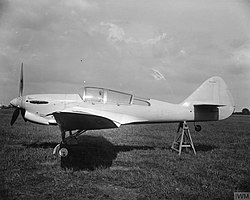Miles Kestrel
| M.9 Kestrel | |
|---|---|

|
|
| Type: | Trainer aircraft |
| Design country: | |
| Manufacturer: | |
| First flight: |
May 1937 |
| Number of pieces: |
1 |
The Miles M.9 Kestrel was a trainer aircraft produced by the British manufacturer Miles Aircraft .
development and construction
The Kestrel (German kestrel ) was the first high-performance aircraft from Miles Aircraft. The machine was a low- wing aircraft with cantilevered wings and elevator and was powered by a Rolls-Royce Kestrel with a rated output of 745 hp (548 kW ). It is not known whether the aircraft, like many of Frederick George Miles' designs, was named after the bird of prey or its engine .
The machine had thick, inverted gull wings with a thickness ratio of about 0.23, which were probably influenced by the flight tests with the Miles Hawcon . The ailerons were on the wings immediately outside next to the slotted flaps . The main landing gear was attached to the lowest points of the wings, which meant that the landing gear legs could be kept short. The landing gear was retracted backwards so that the wheels could turn into the wings. A tail wheel was attached to the stern . Both side and elevators were with a horn balance and trim tabs provided. The machine was made entirely of wood. It consisted of a frame made of spruce wood , which was planked with beech plywood and covered with fabric. The flight instructor and student sat in tandem under a simple cockpit hood made of Perspex with narrow frames and additional windows behind the rear seat. The front seat was roughly in the middle of the wing. The engine drove a three-bladed propeller and was cooled via a cooler opening directly under the nose.
use
The only Kestrel ( aircraft registration G-AEOC) was built as a private company and completed its maiden flight in May 1937. On June 26, 1937, the aircraft was demonstrated at a Royal Air Force air show at the Hendon Aerodrome . The machine's performances were remarkable. It reached a top speed of 295 mph (475 km / h ) at an altitude of 14,000 ft (4,267 m ). This speed was only 15 mph (24 km / h) below that of the single-seat Hawker Hurricane , which, however, had a much more powerful engine . The Kestrel, while not as armed, had mounts for a Browning M1919 machine gun in the right wing and a camera in the left. However, there are no reports of whether this machine gun was assembled. There were also mounts for eight exercise bombs .
After the event in Hendon, the Kestrel was flown as part of the United Kingdom Aircraft Test Serials under the designation U-5 until it was handed over to the military. The Royal Aircraft Establishment carried out flight tests with the machine in Farnborough , the Airplane and Armament Experimental Establishment in Boscombe Down . On August 20, 1941, the aircraft was retired from the Royal Air Force and dismantled by Miles Aircraft in Woodley in 1943 .
The Kestrel was not designed according to the specifications of the Air Ministry and therefore initially did not go into series production . In 1938, however, the de Havilland Don , which had won the tender according to the Air Ministry Specification T.6 / 36, proved unsuitable in use. Therefore, an order for the development of a serial version of the Kestrel was awarded to Miles, in the course of which the Kestrel was further developed into the Miles Master . At the time, the order was the Royal Air Force's largest trainer aircraft . The Master I had some notable differences to the Kestrel. These related to the shape of the rear fuselage and tail, the side and elevator trim and the cockpit glazing. In addition, the cooler was moved from the nose under the fuselage.
Technical specifications
| Parameter | Data |
|---|---|
| crew | 2 |
| length | 29.5 ft (8.99 m ) |
| span | 39 ft (11.89 m) |
| height | 9.42 ft (2.87 m) |
| Wing area | 235 ft² (22 m² ) |
| Empty mass | 4,159 lb (1,886 kg ) |
| Max. Takeoff mass | 5,337 lb (2,421 kg) |
| Cruising speed | 245 mph (394 km / h ) |
| Top speed | 296 mph (476 km / h) |
| Engines | 1 × Rolls-Royce Kestrel XVI with 745 PS (548 kW ) |
See also
literature
- JJ Halley: Royal Air Force Aircraft L1000 – N9999 . Air-Britain (Historians) Ltd., 1993, ISBN 0-85130-208-4 (English).
- AJ Jackson: British Civil Aircraft 1919-59 . tape 2 . Putnam Publishing, London 1960 (English).
- AJ Jackson: British Civil Aircraft since 1919 - Volume 3 . Putnam & Co Ltd, 1974, ISBN 0-370-10014-X (English).
- AH Lukins, DA Russel: The Book of Miles Aircraft . Harborough, Leicester 1945 (English).
- Owen Thetford: Aircraft of the Royal Air Force 1918-57 . Putnam Publishing, London 1957 (English).
Web links
Individual evidence
- ↑ a b c d e A. H. Lukins, DA Russel: The Book of Miles Aircraft . Harborough, Leicester 1945, p. 40, 41 (English).
- ^ A b A. J. Jackson: British Civil Aircraft 1919-59 . tape 2 . Putnam Publishing, London 1960, pp. 490 (English).
- ^ Register Entry For G-AEOC. Civil Aviation Authority , October 6, 1936, accessed May 4, 2020 .
- ^ JJ Halley: Royal Air Force Aircraft L1000-N9999 . Air-Britain (Historians) Ltd., 1993, ISBN 0-85130-208-4 , pp. 141 (English).
- ↑ AJ Jackson: British Civil Aircraft since 1919 - Volume 3 . Putnam & Co Ltd, 1974, ISBN 0-370-10014-X , pp. 340 (English).
- ^ Owen Thetford: Aircraft of the Royal Air Force 1918-57 . Putnam Publishing, London 1957, pp. 336,337 (English).

